#tom is groundbreaking in so many ways
Explore tagged Tumblr posts
Text

succession redditor gets psychosexual confused with sapiosexual. implies that tom is so sexually attracted to GREG HIRSCH'S intelligence he doesn't know how to handle it. unwittingly creates the most hilarious phrase in human history 'sapiosexual harassment'
#it's about time we had some sapiosexuality rep in mainstream media#tom is groundbreaking in so many ways#v sorry to this person#we're on the same team#but this is so fucking funny#succession#g.txt
17 notes
·
View notes
Text
Harry is an iconic character, and many people interpret him in many different ways. That's good!
But I think some "Harry is actually this and that" are in truth "Harry should be this and that".
I don't agree with many choices the author took. But I still admit they're canon. Maybe other choices would have done a better story, but this is.
For example, Harry's stance against murder is super clear. He refuses to let Sirius and Remus kill Peter, the only person to do it.
He fights with many of his adult companions because he's strictly against murder. In DH he uses expelliarmus and everybody knows it's him. When people rebutt him for this, he says that killing people is Voldemort's job, not his.
I really like Harry having a strong moral backbone and not surrendering to the cruel world he lives in. A world where many people want him dead, or imprisoned, or discredited, or such.
Yes, Harry has occasionally violent thoughts, but those are very rare, considering how terrible his life is.
This also makes Tomarry so delicious. Corruption arc? What about Tom being ?????? Because Harry has creative solutions to problems that don't require murder? Groundbreaking.
265 notes
·
View notes
Text
23 Tomarrymort Recs for 2023 (Longfic Edition)
Happy New Year! 🤍 Here is a round-up of some of the most engaging multi-chaptered works/longfics that I came across in this ship in 2023.
I found each of these fics, in their depiction of the ship, to be a fresh or surprising take on our familiar beloved characters of Harry and Tom|Voldemort, truly groundbreaking in some way in their approach to the ship. It's amazing to me that even after 20+ years of this ship existing, there's still new themes / tropes / dynamics to explore, and the authors are all so talented in making me think about the ship in some new way — just incredible examples of what it means to be a transformative work of fanfiction.
Criteria for this list: multi-chaptered, Tomarrymort-centric, with at least 1 update published in 2023. As with a previous longfic rec list, I tried to find longer fics that were relatively under-rated (which is hard to define, but below 2K kudos for the most part).
See here for Part 1 (2023 Tomarrymort one-shots), and hope you lose many many happy hours to the unbridled joy of immersing yourself in one or more of these incredibly addictive, lovely longer fics!
*
23 Tomarrymort Recs for 2023 — Multi-Chaptered Fics
A Darkness by Any Other Name by river_marrow (M, 30k, WIP)
Decades after the war ends, Harry is thrown through the Veil, and finds himself in an alternate reality where the leader of the Muggleborn uprising is the Dark Lord Voldemort.
A Dead God's Faith by @selfishrot (M, 35k, WIP)
Blood and spittle rush to follow Riddle’s words that are dragged out through a wrecked throat. “I will consume you.” Harry felt a thrill run up his spine, along with the usual fear and anger that accompanied Voldemort's threats. “Be gentle, I can feel your soul ripping its stitches.”
And the Living Will Envy the Dead by @k-s-morgan (M, 81k, WIP)
When Harry looks at Tom, he feels overwhelmed. There is a spark that makes him hopeful, the fear that nothing he does will save Tom from himself, and the horror at what his lies might lead to. When Tom looks at Harry, he feels nothing. Until he does, and then Harry’s world starts drowning in blood.
At the expense of the world by @itsevanffs (E, 24k, WIP)
"He had a lover, you know," Jenkins says to Remus once Harry's behind a wall and out of sight again. "A boy, and a gorgeous one at that. Nobody really knew where he came from, and Tom didn't seem to favour him either, at first, but by the end, he was besotted."
Bitumen by @crowcrowcrowthing (E, 32k, WIP)
Harry finds out the hard way that Dementors can’t digest Horcruxes. Now separated from his body, his best option is to seek out a similar soul for help. A love story about immortals with too much time to kill.
Creatures of the Dark we are by @hikarimeroperiddle (M, 25k, WIP)
Banished to his cupboard at age 4, Harry learns to listen only to the Voice in his head. Its teachings wrap all around Harry until no more than dark magic and devotion remains, along with visions of a wraith with red eyes.
Exceeding Expectations by @mosiva (E, 56k, complete)
Harry Potter’s life ran along very different lines than Tom Riddle’s. He knew nothing more of the man than he read in the Daily Prophet. Then they get stuck in a lift together.
Exegesis by liquoricepantomime (M, 38k, WIP)
In exchange for peace, Voldemort asks for Harry Potter. And so, there is a new legacy that forms — of The-Boy-Who-Was-Sold, and his childhood spent in a castle, with a man who has killed his parents. A man who is mad, and whose ire reigns fiery hell. A man he will marry, and yet knows nothing about.
found by @honbug (E, 112k, WIP)
Tom knows from the beginning that he is destined for greatness. Nothing and no one will stop him from achieving his goals. (And then, of course, there are the dreams.)
hook, line, and sinker by @purplemineralwater (E, 21k, WIP)
Harry asks Professor Riddle for help in killing Voldemort. Riddle is endlessly amused.
if we were lovers by @reggieblk (E, 277k, complete)
When Harry arrives at the most prestigious theatrical school in the country, he doesn't have many expectations. The most unexpected thing he encounters is Tom Riddle, and subsequently, falling in love with the only other person who deals with feelings as well as him. But maybe, just maybe, he and Tom will find out that not all love stories have to end in tragedy.
Lover's Spit by @blogalinda & @k3uuu (E, 123k, WIP)
Following his father's arrest on a dull hot Sunday in North Yorkshire, 10-year-old Tom Riddle becomes a dark internet sensation. If Harry Potter listened to his father, he would never speak to Riddle again. But eight years after the arrest, an unexpected and painful encounter leads Harry to reconsider events — and arrive at a conclusion all his own.
One Year In Every Ten by @saintsenara (E, 189k, WIP)
A decade after the final battle, a serial killer emerges, with a message that proclaims the Dark Lord has risen again. Harry is assigned to the case.
Oversight by @dividawrites (E, 21k, WIP)
Voldemort’s resurrection ritual doesn’t go as smoothly as he’d planned. He requires assistance and there’s only one person he can ask—the boy tied to his father’s gravestone.
Paved With the Best Intentions by @perhaps-sunlight (M, 113k, WIP)
Instead of dying during the Battle of Hogwarts, Voldemort de-ages into an infant. Until he becomes old enough to be legally executed, he will be magically bound to Harry.
Prison Blues by @metalomagnetic (E, 68k, WIP)
Harry and Voldemort find themselves locked up in a mysterious prison in an A/B/O alternate universe setting.
Revolution of Configured Stars by @tollingreminiscentbells (E, 110k, WIP)
In a Voldemort Wins AU, Harry Potter was spared, and enters his seventh year at Hogwarts wanting to do Arithmancy research and keep his head down. However, after a chance encounter, it looks like it may not be so simple. Marvolo Gaunt seems to have his eye on Harry. The trouble is, Harry has no idea why.
Tender Reigns Our Night by @noumena-writes (M, 93k, WIP)
Sent on a Ministry mission to fight for magic's survival, Harry goes back in time with two simple objectives: find and destroy any existing Horcruxes, and stop Tom Riddle ever evolving into Voldemort — using any means necessary. Harry thus finds himself working alongside Riddle at Borgin and Burke's, examining dark artefacts and desperately trying to fulfil his orders.
the demiurge, the leontoeides by @ramabear (E, 125k, WIP)
Thomas Gaunt reaches through the dimensions and plucks an eleven-year-old Harry Potter from his world and brings him home again.
the eternal flame by @duplicitywrites (E, 25k, WIP)
There’s a well-dressed older man who enters the orphanage asking after Tom Riddle. The man’s green eyes fix on Tom’s face, searching and searching. “My name is Harry Gaunt,” the man says, the tenor of his voice soft and faltering, a reflection of Tom's deepest, most secret anxieties, “and I’m here to adopt you.”
the righteous dead by @aspengray (T, 23k, WIP)
Harry is resurrected, sewn together with thread and magic. He remembers nothing except that he loves his savior, a man named Voldemort.
The Longing by @aglassroseneverfades (M, 33k, WIP)
Harry is not thinking of his parents right now as he trudges up to Voldemort’s eerie castle. He is thinking instead, as he often does, of a name that burns too brightly on his wrist in the pre-dawn light. He is wondering if somehow the fruitless tugging on his heart means that somewhere, some way, Tom is watching over him.
With a resolute heart by Act_Naturally (M, 157k, WIP)
A Hunger Games-AU featuring Harry and Tom as competing champions. Harry has a saving people thing. It’s not conducive to surviving a battle royale. He doesn’t fancy his chances. Especially against Tom Riddle.
*
#tomarry#harrymort#tomarrymort#tomarry recs#tomarrymort recs#hp fic recs#longfic recs#ao3 recs#fanfic recs#harrymort recs#2023 reads#2023 recs
447 notes
·
View notes
Note
Was anyone even talking about Tom’s style when Law was styling him 😂. I feel like he got the job done but I don’t think Tom has ever been known for his red carpet style. I think recently his street style has been good in my opinion- nothing groundbreaking but I feel like he has found his style and it fits him very well. But, I don’t think people think red carpet looks when they think of Tom Holland (and that’s fine, not insulting Tom or anything). Like Tom is not someone that I’m waiting to see on the red carpet cause I’m anticipating his looks- I anticipate him/his charisma and just hope he looks decent.
That's an interesting way of looking at things. 🤔
I mean, tbh though, there aren't really that many men/male fashion icons or those ego who people are waiting with bated breath to see on the red carpet due to style simply because most male attire is way more straightforward and not as creative as female attire. 🤷🏾♀️
So, yea, maybe most people aren't viewing Tom as some as some fashion icon on the red carpet, but at the same time, to be fair, most male celebrities aren't fashion icons just in general.
There are very FEW males that are alive today that are very well-known for their red carpet style imo. Jmho 🤷🏾♀️
7 notes
·
View notes
Text
Jonathan Bailey's interview with Gay Times (2023)
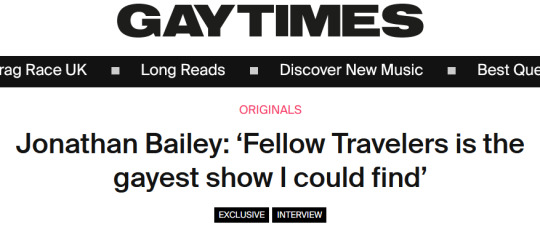

From his work in regency-era dramedy Bridgerton to groundbreaking period piece Fellow Travelers, as well as an upcoming role in the movie adaptation of classic musical Wicked, Jonathan Bailey is blazing a trail as one of the world’s most prominent out gay actors – and activists. This year’s GAY TIMES Honours sees the star succeed 2022’s recipient of the Changemaker Award, Tom Daley, as a result of his new partnership with the official LGBTQIA+ young people’s charity Just Like Us, a collaboration he describes as “critical and crucial”: “LGBTQIA+ issues don’t speak for themselves, and you need people to step forward. It’s important for me to be able to do that.”
Three days after his infectious, frenetic energy made its mark on the GAY TIMES set, a freshly bronzed Bailey is preparing for yet another shoot in Marrakech, Morocco. Speaking from Zoom, he laughs (slash glows): “I’ve been sent out early just to get a tan.” After reminiscing on his “spiritual” on-set discourse about zodiac signs with our fashion and creative director, the aforementioned frenetic energy is back on display as he immediately dives into his Just Like Us partnership. “I’ve worked with Albert Kennedy Trust before, and there’s so many different charities that I look forward to working with,” he says. “Just Like Us really hit something that I felt was important. One thing is, how can people describe what they’re feeling and experiencing if they don’t have the vocabulary and tools to do so?”
Since Just Like Us was founded in 2016, the charity has collaborated with primary schools, secondary schools and colleges across the UK to improve the lives of queer youth. Their annual, UK-wide celebration of LGBTQIA+ awareness, School Diversity Week, sees thousands of schools take part with student talks and assemblies led by their Ambassador Programme, which trains LGBTQIA+ people aged 18-25 to speak about allyship and their own personal experiences with sexuality and/or gender identity. Bailey tells us that the partnership comes after an “extraordinary shift of years of opportunities and possibilities” via his various projects, from Netflix’s smasher Bridgerton to Showtime’s new LGBTQIA+ series Fellow Travelers and his upcoming role as Fiyero in Wicked, which will also star Cynthia Erivo and Ariana Grande. “I now have a platform by which I can help guide people towards different narratives and causes.”
Laura Mackay, CEO of Just Like Us, praises the star’s activism in the following statement to GAY TIMES: “It speaks volumes about the calibre of our programmes that Jonathan Bailey has decided to join us as a patron. When we met with him to discuss the vital work we do, Jonathan spoke with vigour and sincerity of his unwavering commitment to improving the lives of LGBTQIA+ young people. I am so impressed with our Just Like Us team for creating this partnership and engaging such a wonderful role model. Jonathan oozes panache and gravitas, Just Like Us.”
First visiting the charity at their headquarters in July, Bailey was “blown away” by the team and their ambassadors. Praising their “assuredness, confidence and eloquence” in what they aim to achieve in schools, Bailey admits that he would “never have been able to speak” on LGBTQIA+ issues like that at their age. “There’s so much for me to learn,” he shares. “There’s just something that happens when people speak authentically about their identity in a way that is generous, because they want to connect and tell their story. I was there with my jaw slightly on the floor. I thought, ‘If I had met either of these two people when I was younger, I would’ve been so starstruck’ because they had such ownership of who they are. They had such charisma without shying away from the unsurprising vulnerabilities and obstacles they’ve had to overcome.”
Describing Just Like Us as a “supernova ball of energy” due to their united front in transforming the way in which schools across the UK discuss LGBTQIA+ matters, Bailey lauds the diverse and “enriching” stories that have been told via their ambassadors. Over the past four years, GAY TIMES has partnered with the charity on numerous occasions, with their ambassadors sharing their unique upbringings and experiences with oppression, resistance and hope. A selection of stories featured this year include: ‘As a Brown, Asian, Muslim LGBTQIA+ person, Middlesex Pride felt like home’; ‘Films taught me that LGBTQIA+ and faith identities couldn’t co-exist – but that wasn’t true’; and ‘How Loveless by Alice Oseman helped me discover my aromanticism’.
“I was particularly struck by the fact that there seems to be a knock-on effect of how many people linked to the ambassadors and their friends then jump on board because they see how beneficial it can be,” explains Bailey. “Not just for the people in the schools who are receiving those speeches and interactive sessions, but also for the ambassadors themselves.” Just Like Us is notable for their Pride Groups programme, where they help secondary schools set up and run lunchtime clubs for LGBTQIA+ pupils and their allies to learn, make friends and have a place in school that is free from homophobia and transphobia. Additionally, Just Like Us launched their landmark Positive Futures report earlier this year. Surveying 3,695 people aged 18 to 25 from across the UK, including 1,736 LGBTQIA+ young adults, the report identifies a link between lack of LGBTQIA+ support in childhood and poorer outcomes for mental health, wellbeing and career prospects in adulthood.
“It’s interesting hearing about Positive Futures and the difference between queer youth either being surrounded or in a nourished environment where people freely talk about identity and labels, versus kids that don’t,” he says. “The opportunities it gives them in young adulthood, as well as the increase and decrease in anxiety and panic attacks and depression; purely on the basis of their identities being acknowledged at a younger age. It’s huge. The correlation between conversation and the vocabulary that comes with that leading to a happier life is just… It’s undeniable.”
Clear communication about LGBTQIA+ issues was scarce – rather, non-existent – when Bailey was at school. The partnership forced him to reflect on his “own upbringing, what has changed and, more crucially, what hasn’t changed. One of those things for me was about education, schools, and growing up and my own youth.” For a recent Fellow Travelers campaign, Bailey returned to his home village in Brightwell-cum-Sotwell, a place where anyone who was “other” was “deemed not acceptable”. “That’s how I felt growing up, purely on the basis that I wasn’t aware of any gay people around me,” he says, criticising mainstream media’s archaic portrayal of LGBTQIA+ people at the time. “The media spun stories that were so negative towards the plight of the gay experience, so I didn’t really have access to anything that made me feel welcome or like I was going to be okay, and I was someone who was very aware of who I was. I talked about it from the age of eleven. I wonder what my life would’ve been like, had there been the vocabulary and ambassadors coming into my school. It would’ve definitely helped me feel more secure and to blossom quicker. For me, that sort of confidence in myself has come later on in life because of not having that.”
Immediately after Bailey completed his A-Levels in 2006 – the day of, actually – he moved to London to replace Andrew Garfield in a stage adaptation of the cult queer rom-com Beautiful Thing. As an 18-year-old from a rural village, the multicultural hub of London allowed him to “accrue information and experiences” that weren’t previously accessible to him. “It was meeting amazing people. I wasn’t anywhere near the point where I was going to come out to people I didn’t know, but I already had conversations with my friends,” he remembers. “So, moving to London was sort of a patient and nerdy acquisition of facts and experiences, which emboldened me to the point where I could finally talk to my family [about my sexuality], particularly my parents.” Assimilating to the inclusiveness of London made Bailey project his own growth onto his school, assuming that it would have been transformed into a “multicultural hub with clear access to education or information to anyone who wasn’t a white straight kid”. However, as he discovered: “It wasn’t, actually. What was true is that the same tree of Christianity and faith, with the same laminate piece of paper from when I was there, is still on the wall. Of course, I’ve got no judgement on any of that, other than it’s a reminder of the work that needs to be done for those who are trying to survive. How do you inspire people to understand things outside of their own experience, if they don’t need to or it doesn’t suit them or challenge them?”
Fellow Travelers ties in with his Just Like Us partnership, he says, as it has allowed Bailey to look at the “underside of the queer experience”. Airing on Paramount Plus in the UK, the series is based on Thomas Mallon’s acclaimed novel of the same name and follows the toxic romance between Bailey’s character Tim Laughlin and Matt Bomer’s Hawkins Fuller in the shadow of McCarthy-era Washington. Created by Oscar nominee Ron Nyswaner, Fellow Travelers chronicles their romance over the course of four decades whilst exploring the Vietnam War protests of the 1960s, the “drug-fueled disco hedonism” of the 1970s and the AIDS crisis of the 1980s. His first major LGBTQIA+ project, Bailey says “you can’t get more queer than Fellow Travelers” and adds that “it’s the gayest show I could find.”
Quite correct; the first episode introduces the sub-dom dynamic between Tim and Hawk with a now-infamous foot-fetish sequence which, unsurprisingly, spawned a plethora of horny headlines (yes, we’re guilty of this) and went viral on social media. The remainder of the season continues to depict gay sex with authenticity which is, sadly, still a surprise in 2023. When we spoke with Nyswaner, he told GAY TIMES that it was important for him to “embrace” sex in the show as a result of his own personal experiences. “When I came out in the 1970s, those were the celebratory days of the gay experience. It was pre-AIDS and we were released. Sex is the way that we expressed our community,” he explained. “That connection that I got to have with other gay men, whether it was one night or a little bit longer, was very powerful to me and gave me joy.”
Bailey says Fellow Travelers came “at the right time”. “Someone asked me after Bridgerton, ‘What do you want to do next?’ and that is an amazing position to be in, having worked for so long to suddenly have real choice in what you do. I knew that I wanted to do a sweeping gay love story because I hadn’t seen it, especially one that’s detailed over eight hours.” While Bailey admits he doesn’t respond to fans on Instagram – with over three million followers, we’ll let him off – he’s read “extraordinary” messages from people who have connected to Fellow Travelers’ story. “People have messaged saying, ‘I’m closeted but watching this is helping me in a way that you might not understand.’ Someone else said it made them come out, and these are people in their 40s and 50s. There’s these lost generations that Fellow Travelers is highlighting, people who are more scared than ever to feel invalidated if they were to finally come out and speak their truth. I’m mindful of the fact that there are people of every age who are striving to live authentically.”
With this in mind, Bailey continues: “It’s funny, people look at the 1950s setting for Fellow Travelers and say, ‘God, how awful must it have been back then?’ We’re incredibly privileged in the west. Fifties America is pretty much everywhere else in the world, and still can be. There’s so many places where people are experiencing that level of oppression and so I’m really proud of Ron’s work because it presents 40 years of an incredible celebration of progression.” In October, Bailey attended the Human Rights Campaign’s 2023 dinner, where he presented Bomer with the Impact Award, which recognises members of the LGBTQIA+ community who are dedicated to championing and advocating queer issues. Bailey’s Bridgerton co-star Golda Rosheuvel also introduced Shonda Rhimes, the recipient of the National Equality Award. His first political gala, Bailey describes the event – a room of over three thousands queer icons, allies and activists – as “enthralling, energised and inspiring” and was another pivotal moment of self-reflection for him. “I was like, ‘Blimey, if you think about the 12-year-old boy who knew something about himself, knew 100 per cent that he was not like other people, to then be in a room where he feels completely galvanised and inspired…’ That sort of joy, ferocity and forward-thinking is so intoxicating and important for people to feel because there’s also so much residue. The vitriol and hate is always bubbling under, so you need organisations like Just Like Us who are going to be going into schools to culture students at a young age and make them think outside of their own narratives they get given at home by their parents or films and stories that aren’t helpful. It’s a better landscape for us all, really.”
With the “cobwebs of old archaic belief systems about what a gay man can and can’t do as an actor,” Bailey is proud to be accepting the Changemaker Award, describing it as a “fully realised vocation to make change”. He’s humble, of course, as he takes the time to acknowledge the internal, grassroots operation at Just Like Us and their objective to revolutionise the experiences of LGBTQIA+ youth. “Once you’ve done the work as an actor in this way, all you have to do it turn up and be there,” he says. “The real work comes from the people who are working at Just Like Us, the charities and support groups who have to constantly chug away to get the funds and be noticed. There’s a glimmer in me that knows the work is done elsewhere. But my God, I’m thrilled that I can use my platform to raise the volume on so many other people’s brilliant policies.” Bailey credits his role as straight lead Anthony in Bridgerton with his power to incite change within the LGBTQIA+ community. "As one of the world’s most streamed and acclaimed dramas, Bridgerton’s impact is undeniable. You get a fanbase and it’s almost like a conga line, where you can then lead those people to other stories which feel really important to you. To be able to go from that to Fellow Travelers and Just Like Us is something I’ll be proud of for the rest of my life.”
Source
#jonathan bailey#jonny bailey#just like us#just like us charity#fellow travelers#gay times#gay times interview#interviews:2023#interviews#lgbtq+#lgbtqia#NEW!
42 notes
·
View notes
Text
To Be Continued: Multi-parters in Star Trek (Part 3)
By Ames

While Deep Space Nine may have been king of the serial story arc, as we discussed last week in our multi-parter chat, Voyager may have been the most successful at connecting their two-parters. Unlike many [most] of the TNG two-parters that we thought really should have been one episode, when Voyager spanned weeks, it actually felt like their writers planned ahead more often than not.
A Star to Steer Her By is voyaging through this batch of “To Be Continued” stories this week to see if that hypothesis holds up when Janeway is in the captain’s seat. So grab a cup of coffee from your favorite nebula, check them out below, and listen to our chatter on this week’s podcast episode (slipstream over to 48:52) to see when we were rapt by a season cliffhanger and when we were nonplussed by obvious efforts to stretch a plot. Next time, on Star Trek: Voyager!
[Images © CBS/Paramount]

VOY: “Basics”
Okay, like our first example from Deep Space Nine last week, our first Voyager example of a two-parter is not helping me prove my point at all. The season 2 finale / season 3 premiere was just uneven all around, and the main issue is that the writers clearly had no plan for what to do with the Seska plot. Would they kill Culluh? Would they kill the baby? Nah, let’s kill Seska in the least satisfying way possible. Ugh.
Speaking of not satisfying, we also never get the confrontation scenes we wanted even though there was plenty of time for them across two episodes. There’s no closure between Seska and Chakotay. Janeway never gets to gloat in Maje Culluh’s face that a woman finally took him down, which she’d predicted ages ago. And my fave Lon Suder, while dying in an admittedly beautiful blaze of glory, really should have been the one to take down Seska. Or vice versa. Something more personal and meaningful, dammit.
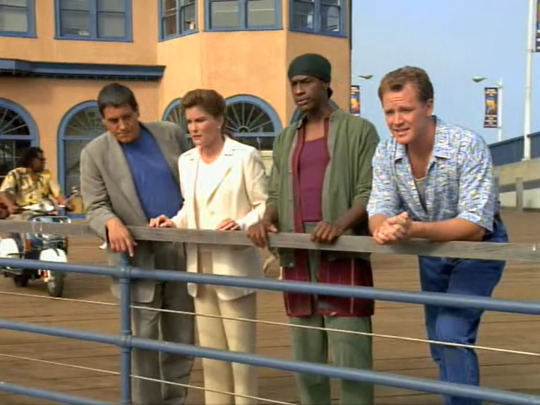
VOY: “Future’s End”
Our foray into the past in “Future’s End” fares a little better. Sure, it may have run a little short, and the whole Torres-Chakotay plot out in the Arizona desert seems squicky and superfluous, but these episodes succeed in keeping everyone busy across both their runtimes. The EMH notably gets his mobile emitter, Janeway looks great in that pantsuit, Tom and Rain are super super cute together, and Neelix and Kes even get addicted to soap operas! There’s a lot to love here.
The villain, Starling, is kind of a one-dimensional baddie, and the time travel paradox contradicts itself if you think about it for more than a couple seconds, but these were episodes that knew how to fill their runtime with some fun romps in the past, to sprinkle in some cute fish-out-of-water jokes, and to save a lot of expense by setting things contemporaneously. And what’s the point of a two-parter if not to save a couple bucks?

VOY: “Scorpion”
A more successful season finale / season premiere bridge comes between 3 and 4 when we really start to engage the Borg, something Voyager did with such aplomb it almost feels trite. Almost. But Borg are just too good to pass up, and this introduction of not only the Borg, but Seven of Nine AND Species 8472 has so much going for it. Even if one could argue (as we often do) that it follows the beats of “The Best of Both Worlds” a little too much, is that such a bad thing?
Sure, Part 1 is mostly all setup and the cliffhanger can’t compare to something so groundbreaking as “BOBW,” but Part 2 is where the action is. When the opposing objectives of Janeway and Chakotay clash and clash and then finally compromise into a plan that highlights both of their strengths, it is a thing of beauty. Resistance is definitely futile.

VOY: “Year of Hell”
Ironically, what was originally going to be the season 3 finale / season 4 premiere ends up working absolutely stunningly in the middle of a season. “Year of Hell” could have stretched out into a four-parter, as was originally intended, but then the hard reset at the end would have really felt like a slap in the face. After two episodes, the climax provides just enough of a rug pull to feel cathartic and not like a letdown—something most hard resets can’t pull off like this.
And what episodes these are! They really benefited from two hours spent wrecking the Voyager and her crew more and more. One episode would not be enough time to see and really appreciate the progression into despair that we experience. We really get to know Annorax and start to wonder, like Chakotay does, if we can fix him. And Janeway gets to self destruct the ship! Her favorite thing! A+

VOY: “The Killing Game”
I love that in our initial coverage of “The Killing Game,” Chris’s reaction was “This shouldn’t have been a two-parter” and Jake’s response was “This should have been a six-parter!” There was something different we wanted from these episodes, and it’s hard to put our finger on just what that is because this two-parter is all we have to judge. We’d love to see options in which the characters get their identities back much earlier OR much later, because somehow the balance just seems off the way it currently is.
These episodes also first aired back to back on the same night, so initial audiences also didn’t have to worry about the cliffhanger leaving them in any suspense. And it could have paid off better: we definitely demanded more of the holodeck programs bleeding into each other like was promised in that final Part 1 scene! While it was a blast to have the Klingons attacking Nazis, taking it further would have been immeasurably more fun! Where’s da Vinci? Where’s that nanny from the Jane Eyre program? Let them take out some nazis too!
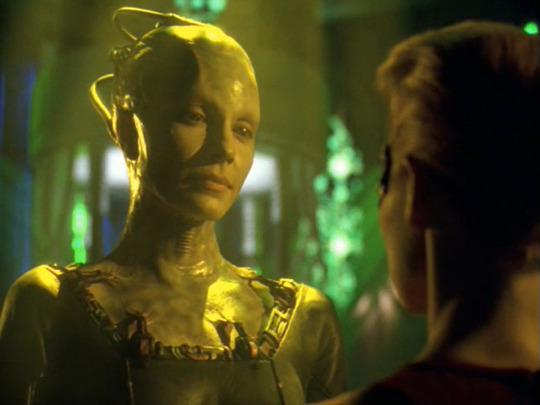
VOY: “Dark Frontier”
I may be biased because of how much I love me some Borg Queen, but “Dark Frontier” similarly nails the double-length slot. This one was also feature-length, all delivered as one big episode on the same release day, so obviously the writers knew enough to plan it out ahead of time and really get the pacing right. Like “The Way of the Warrior,” which we talked about last week, it feels like its own little Voyager movie.
And it’s got a lot going for it: We get the Borg sphere heist, we get a ton of Seven’s backstory with her utterly neglectful parents, we get a pretty decent Borg Queen–assembly scene, and we get the rivalry to beat all rivalries: Janeway/Borg Queen. Anyone who thinks Borg Queen and Picard are the biggest enemies of the franchise utterly forgets that this is the matchup to bring the audience to its feet.
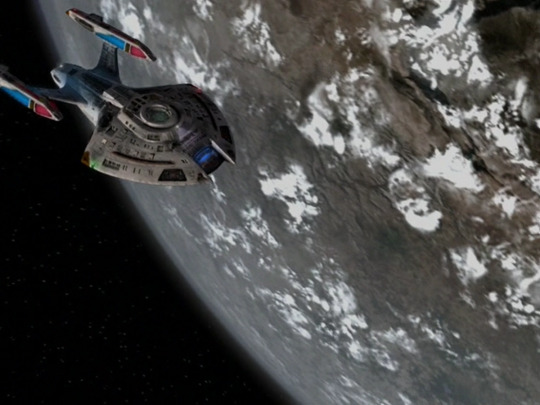
VOY: “Equinox”
Apparently when “Equinox, Part I” concluded season 5, there wasn’t a full plan for how to get out of its scrape in season 6. And you could have fooled me because they nail it! Somehow Part 2 is even better than Part 1. Maybe it’s the more thorough exploration of the darker actions these characters take to survive. Maybe it’s the layers and layers of scheming we get from the Equinox crew—Ransom and Burke and Evil-EMH all devour the scenery like it’s a Thanksgiving meal. Maybe we just like it when Janeway breaks some knees.
The main gripe we have about this two-parter is that its lasting effects pretty much terminate with it. Even though the Voyager has picked up the remnant crew from the Equinox, we never see them again in any real capacity. And what a shame! These are characters that could have entered the cast with so much potential to dig into their stories, and that’s just it. Rats.
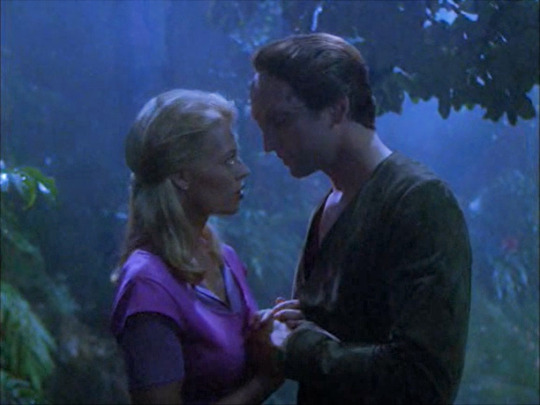
VOY: “Unimatrix Zero”
Like “Scorpion” above, we’ve got another example of Voyager trying real hard to be “BOBW.” The cliffhanger at the end of the sixth season has not one, not two, but three members of the crew get assimilated by the Borg! So it’s Locutus cubed (Locubus?), I suppose. But you know what, if you’re going to crib from an existing successful episode, it pays to pick the best, because Janeway and crew end up with a pretty watchable little story here!
Not all of the hosts of A Star to Steer Her By cared for the romance sideplot between Seven and Axum, but this Matrix-style haven for Borg drones is a very fun idea! The stakes keep getting raised with every passing scene, with Tuvok losing his humanity (Vulcanity?), Borg cubes getting annihilated on a whim, and our beautiful haven going up in flames. And there’s more Borg Queen action! Really, what better can this show do?

VOY: “Flesh and Blood”
Another very fun idea is having a whole bunch of holograms gain sentience and take over a ship. Like, seriously, how cool is that? Did this one have to be a two-parter? Unclear, but I don’t remember ever being bored or feeling like the plot was spinning its wheels to fill up time. And this was another feature-length episode that all got released on the same day, so it’s possible people didn’t notice.
Some of the elements we get are pretty enticing! EMH [yet again] has to choose between the ship where he belongs and some new population that he finds kinship with. Our Cardassian hologram Kejal starts an adorable little galpal-ship (is there a word for that?) with Torres. Really the one big flaw is the predictable ending having Iden turn out to be an megalomaniac in the eleventh hour, which is a crying shame.

VOY: “Workforce”
Our final outing is another familiar one. “Workforce” features the whole crew brainwashed and living an alternate life for the benefit of their captors, a pregnant B’Elanna Torres, Harry Kim and the EMH both unaffected on the outside trying to get everyone back, and Seven’s Borgbrain being used to snap her out of it. Uh, “The Killing Game,” anyone?
Not that there’s anything wrong with telling the same story again, and this is a decent one at accomplishing that. As with “The Killing Game,” it’s a fascinating watch to see everyone running around as different people (memory wipe episodes frequently make interesting statements about a person’s true nature, after all), and just as entertaining seeing Tuvok and Seven learn their true circumstances, albeit to different results. Congrats, Voyager! You did it!
—
Join us next week for the thrilling conclusion of our multi-parter series, when we will tackle all the two- and three-parters of Enterprise, which are somehow weighted almost entirely to the fourth season. Make sure you’re also listening along to the podcast on SoundCloud—or wherever you get your podcasts—as we rewatch all of Star Trek: Discovery, and chat with our little mini Borg collective over on Facebook. And remember: when in doubt, copy “The Best of Both Worlds.”
#star trek#star trek podcast#podcast#voyager#star trek voyager#basics#future's end#scorpion#year of hell#the killing game#dark frontier#equinox#unimatrix zero#flesh and blood#workforce#borg queen
3 notes
·
View notes
Text
May Comics Round Up!
I didn't think I got all that much read this month, but it looks like there's a decent amount!
Swamp Thing (71-90) (1988-1990)
Swamp Thing tells a good story as always, and is delightfully messed up in many ways. Intertwined a bit with the start of Hellblazer at this point, so read them together!
The Demon (1-4) (1987)
Missed this mini last month, so grabbed it this time around. A pretty good sequel to the 70s run, and ends with Etrigan kissing Blood on the mouth as they break up, so I think it's a success.
Invasion Event (1-8 + all tie-ins) (1989)
This is a fun event! It is also where the term 'meta-human' originates, so check it out if you wanna get that history.
New Guardians (6-12) (1989)
Sort of a mediocre run overall. Definitely groundbreaking, but you can tell that the guy with the vision left after the first couple of issues (because dc wouldn't let him be as progressive as he wanted to be with the story). Makes me wonder if Tom continues to be a fully enlightened being when he shows up in GL issues after this (if he doesn't they're all cowards)
Plastic Man (1-4) (1988-1989)
A fun gag comic mini. Good for an intro to the character, and it's neat how each issue starts with detailed "serious" comic art that then becomes v stylized and fun.
The Spectre (21-31) (1989)
Oh boy did this go places in the finish. The first half of this run has an entirely different vibe then the second half and neither of them really do it for me.
Dr. Fate (1-14) (1988-1989)
Look the new Dr Fate is sooo wierd, they are just wildly going places with this whole thing. Old Lord of Order Nabu is now a grumpy couch potato, the new Dr Fate duo have no idea what they're doing and consist of a kid that's been aged up to adulthood and his v young stepmom, and also they are soulmates. No idea where they at gonna go with this after they've killed Eric off.
Hellblazer (1-26) (1988-1990)
I like this one a lot, as serious titles go. It really is amusing the difference between Constantine in this title and in Swamp Thing. In his own title he struggles to travel around England, hitchhiking and train hopping and the like, compared to how he's jetsetting around the world in Swamp Thing.
The Question (Annual 2-33) (1989)
The Question is always quality, and also Shiva showed back up!! Many things happen, and also Hub City is literally the worst. Gotham and Bloodhaven think that they are the worst but it is 100% Hub City sorry guys.
Action Comics Weekly (609-641) (1988-1989)
Or at least the bits that were Black Canary/Dead Man/Phantom Stranger/Nightwing/Speedy/The Demon/Phantom Lady (i am not immune to the power of tits okay). These little stories were all really fun, and super easy to miss if you don't have a reading list to follow (I was following a Roy list, then backed up to catch the Dinah stories story) However, the Demon story there at the end had Jason and Etrigan back together already, so I looked up a reading list for him and discovered:
Cosmic Odyssey (1-4) (1988)
Read this to find out how Etrigan and Jason got back together. I love the fourth world. I have many things to say about it and I have written out some of that already. Jim Starlin is my enemy.
Secret Origins (26-38) (1988-1989)
Catching up on folks changed backstories for the post crisis era pretty much
Green Arrow (14-16) (1989)
Only just got started on Arrow at the end of the month! I'll read more now!
Bonus: weeks 5-9 of the Comic Kon superboy reading club! We've finally made it to the Superboy solo! But boy, does that start off getting caught in every big event around, the extra credit has to work hard!
#i guess going on vacation does give u time to read some comics AND draw#nik reads dc#monthly roundup
3 notes
·
View notes
Text
‘The Curious Case of Benjamin Button’ appreciation post!! Long post so i’m putting it under the cut (the rambles of a mad man).


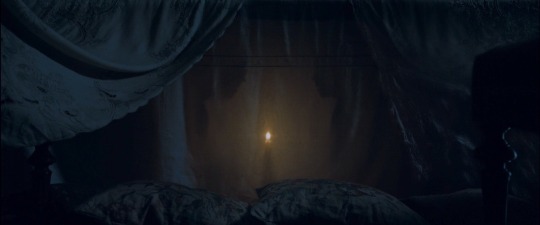
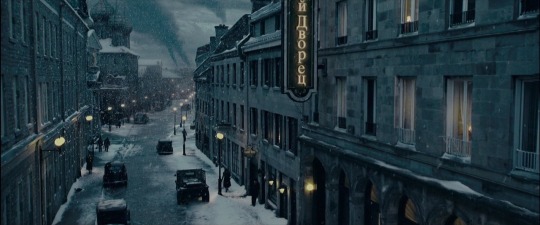
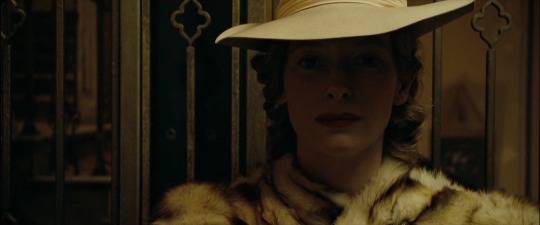
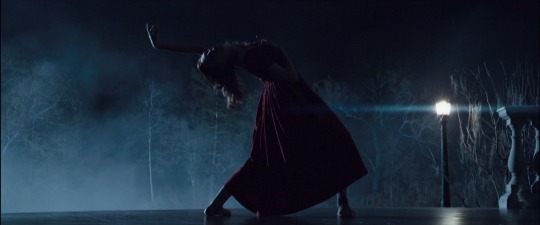
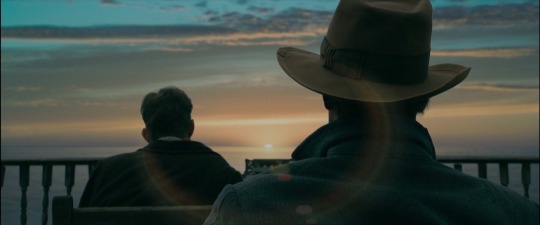
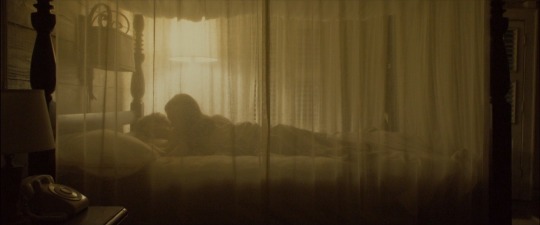
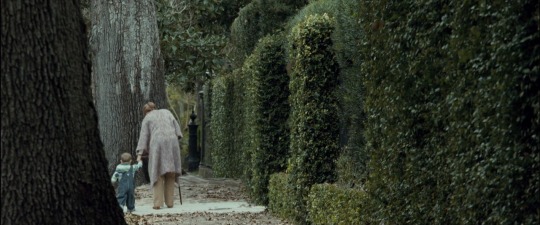
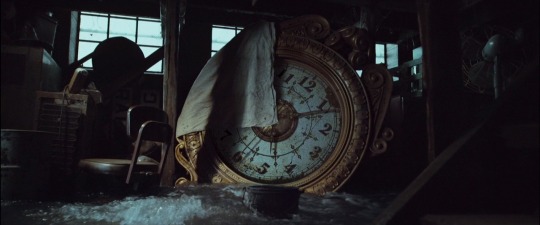
This is the first David FIncher film i ever saw and i think i watched it when i was round 8 or 9 years old. And i only enjoy it the more i watch it. For being Fincher’s second biggest grossing film, and yes i know it won three academy awards ,but i still feel like it doesn’t get talked about enough 😭. When i see people ranking Fincher’s films, this is barley in peoples top 5. Someone called this “Fincher’s most beautiful film” (i think it was in a video essay i watched or something) and i wholeheartedly agree.
Alexandre Desplat’s score is so gorgeous and paired with Claudio Miranda’s cinematography IS SO FUCKING BEAUTIFUL AHH. Cate Blanchett’s performance is fucking insane (she gives my fav performance in this film), along with Brad Pitt’s, Taraji P. Henson’s and Tilda Swinton’s just to name a few. Not to mention Jacqueline West’s costume designs for this film HOLY SHIT!!! because it takes place over a persons life, she gets to have a lot of creative freedom with capturing the fashion of the different decades and SHE KILLS IT EVERY TIME!!!
This film gets compared to ‘Forest Gump’ a lot with Eric Roth writing both films (and yeah the story’s are very similar lmao, but also very different). But my hot take is ‘Benjamin Button’ is better than ‘Forest Gump’, i just personally prefer the more serious story more and, as i have said earlier, the performances are so incredible. (also there is a really good video essay by ‘Eyebrow Cinema’ titled ‘The curious case of Forest and Benjamin’ on youtube that compares them really nicely if anyone cares :3)
I could go on for literal hours about how it took decades to actually create this film, all the different iterations of the script, all of the different people that were attached to this film over the many years that it was in development such as Steven Spielberg, Spike Jonze, Tom Cruise and literally SO MANY OTHER PEOPLE. Obviously the groundbreaking VFX and CGI which kind of changed the film industry (in-terms of this levael of VFX) are literally so fucking crazy!! not only to give Brad Pitt the appearance of an 80 year old man ALL the way down to like a 17 year old, but also aging and dragging Cate Blanchett both with both VFX and make up! Just to name a few reasons why i love this film so much!!
if you got down this far THANK YOU FOR READING MY RANT!! i just think this film should be talked about a little bit more (in terms of Fincher’s filmography anyway) because it’s so good 😭!! also i literally barely scratched the surface of how insane this film was to make and honestly i’m not sure how it even got made, but there is a VERY COOL AND EPIC behind the scenes documentary on the blue-ray special features entitled ‘The Curious Birth of Benjamin Button” that i could not recommend more!! (i don’t think it is online anywhere but if i find it i’ll post the link if anyone cares lmao)
#long post#time for a rewatch i think#also fun fact this is Finchers longest film at 2h and 46mins :3#also brad pitt’s monologue at the end of the film is one of my fav monologues in film!!#the way Fincher and Roth make me care about EVERY SINGLE character no matter how small their role is so amazing#anyway go and watch this film#the curious case of benjamin button#benjamin button#david fincher#brad pitt#cate blanchett
9 notes
·
View notes
Text
Results are in for poll #2


I’m honestly not too shocked by the answers that were given and, let’s just say relieved that others weren’t given is an understatement.
I figured the best way to respond would be to go one by one and explain more to help educate:
1. “I love the actress, no matter the role, so her taking a Jewish role was fine”
Unfortunately no matter how talented someone is, they can’t change their ethnicity on screen. It would be like saying that you love Angelina Jolie no matter what and it was fine that she played an Afro-Latino in Pearl, or if they had Tom Holland play a Latino character. Loving someone doesn’t make it okay to erase a minority.
2. “I didn’t know “Jewish” was an ethnicity and not just tied to a religion.”
This having a lot of votes didn’t surprise me at all. Jewish is very much an ethnicity, and actually there are a few different Jewish backgrounds. There’s Ashkenazic (Eastern Europe), Sephardic (Spain, Portugal, Italy, Turkey, Iberia), Mizrahi (Oriental), Ethiopia (and I’m assuming the rest of Africa?). So not only is Jewish itself an ethnicity, but further than that, depending on what Jewish background you have, everything could be different. Judaism is the religion and a Jew is a part of the ethnoreligion. Meaning that the two are intertwined. A Jew may not be religious, but they may keep traditions that are a part of the culture or they may do absolutely nothing and are still just as Jewish as someone who goes to services every week. You’re a part of a tiny little (but strong) tribe of people, being Jewish is literally in your blood (yes, that includes you converts, you have Jewish blood and soul too).
But the biggest reason why this answer doesn’t surprise me, is that on TV or in movies, Jewish characters are never allowed to just exist. It always has to be tied into a Jewish plot. Sometimes that’s playing them for a joke, other times they’re a WW2 victim, other times they’re extremely religious. Jews are so rarely ever shown just being people without the religious aspects tied in. So it’s not surprising that non-Jews don’t know that a lot of Jews aren’t even religious, hell there are a shit ton of Jews who are outspokenly Atheist but super duper Jewish. If films or shows had Jewish characters that didn’t have any sort of religious connection, it would show that Jews are more than a bagel, a Torah, a lawyer/doctor/banker, Orthodox, etc.
That’s why RWRB erasing a Jewish character who was accidentally an amazing example of a 22 year old explicitly Jewish girl who was just Jewish without being overtly religious in any way would’ve been groundbreaking.
3. “Other answer, I’ll explain more…” Please do!!
4. “I didn’t know “Jew-Face” and Jew-erasure in the media was a big deal.”
Sarah Silverman coined the term Jew-face to give a name to when a non-Jewish actor is cast to play a Jewish actor, based on their physical features. Take Rachel Sennott in Shiva Baby or Patti LuPone in like 5 different things. They’re both Italian. But the term has evolved to cover any non-Jew playing a Jew. Much like Black-face, Yellow-face, and Red-face, this is something that is clearly not okay. That’s why performers don’t do any of the latter 3 any more, yet because many don’t understand that Jewish is an ethnicity or why it’s bad to erase Jews, it continues. 9/10 a Jewish character you see on TV or in a movie isn’t a Jewish actor. Most of the Marvelous Mrs Maisel cast— not Jewish. Most of The Goldbergs cast— not Jewish. Most of the Transparent cast— Not Jewish. The new Spielberg movie— Not Jewish. You see what I’m getting at? There may be a few Jews here and there, mainly in comedies or just by happenstance that the actor was Jewish and they ran with it, but explicitly Jewish roles are normally always given to non-Jewish actors. That would never be the case with any other ethnicity in 2023.
5. “I like Nora being a POC and I didn’t know Jews could be Black (or any race).”
Another answer that really didn’t surprise me. This is because on TV and in movies 1: you rarely see any actual Jews, and 2: You definitely never see Jews of more diverse colors and backgrounds. Jews can be Asian, Black, Hispanic, literally anything you can imagine. Some by conversion, but a lotttttttt were just born Jewish. I don’t want to speak over any Jew of color, but I can make the likely true assumption that it probably fucking sucks for people to assume they aren’t Jewish simply because of what they look like. I’m grateful I was raised Reform, so I grew up surrounded by diverse Jews as far as the eye could see, but unfortunately since Jews are a minority anyway and Jews of color are only a small fraction of an already small fraction… It’s not shocking that people think they don’t exist. What RWRB could’ve done, if they wanted Nora to be played by an African-American actress, is they could have found a girl who was Jewish and Black. I promise, they exist.
6. “I understand that it’s wrong! Changing my mind! RWRB did something bad!”
Amazing! So glad! Please post about it or reblog any of my posts. What they did was really not okay and we can’t let this slide.
7. “I didn’t know the rest of the cast was accurately portraying their ethnicities.”
To the absolute best of my knowledge, every other actor cast in the film who has a character with a minority background is of that background. South East Asian playing South East Asian. Mexican-American playing Mexican-American. Etc. It seems that the only character not portrayed accurately is the only character with a Jewish ethnicity, and even if she wasn’t the only one, hopefully you understand why it would be wrong in any production.
As always, if you have questions, comments, or concerns… DM, Anon, Comment, or leave ‘em in the tags
#rwrb movie#red white and royal blue#red white royal blue movie#rwrb cast#rwrb#red white and royal blue movie#casey mcquiston#red white royal blue cast#nora holleran#rachel hilson#red white royal blue#jewish#cmq#rwrb film#nora rwrb#booktok#lgbt books#jumblr#american jews#Jewish actors#Jewish people#amazon prime original#amazon prime video#amazon studios#rwrb book#rwrb spoilers#rwrb social media
24 notes
·
View notes
Note
“Like the article states, today Prince would be accused of appropriating a queer aesthetic. I think there is a chance H might meet that fate. People are already noticing the discrepancy between H on stage performing and H off stage, and 11.6k mill aren’t very happy about it...”
Okay and so what is the conclusion to not meet the same fate as Prince for H in your opinion? Easiest way to get out of it and get an actual support of queer community is to come out but S*ny won’t let him and I’m not even sure if he wants to do it right now. He already kind of indicated that he’s not straight by talking about his sexuality that a) he won’t give an answer to this question, b) mentioning something like everybody has to explore their sexuality and get comfortable with it (no straight person would say that imo) and c) telling that he’s open about his sexuality with his family and closest ones (again no straight person would need to say this) + many many many more indicators like “not that important”/“don’t knock it until you try it” and whole rainbowbears thing but again, gaslighting, short memory or actually no memory at all (because most people noticed him post 1D) and heavy stunting blinded everyone and so I doubt people actually remember these words. And while imo it’s sus he wanted and got the role of closeted gay man for the movie when he’s not actually a pro actor, because it happend during h*livia and the shitstorm her movie caused, nobody stoped to think why he wanted that Tom Burgess that much.
Hi, anon!
The clear solution is to come out as you say, but he's obviously not in a postition to do so now.
So the next best solution for Harry is to bridge the gap. Make the two extremes less extreme, so the image seems more authentic and the real him. So he can either lay off stunting with women for awhile, stop pushing the female connections in the tabloids and stop with het lyrics. Or he can turn up the queercoding off stage, visit gay bars or publically befriend queers. For every straight thing he does he needs to double down on the queer for people not see him as straight. Heteronormativity is so ingrained in people. Little queercoding and a straight relationship splattered over the tabloids makes it seem like the queer projecting he does on stage is only performative and not a part of the real him.
I think he should do a bit of both, as to be a bit more consistent. For H this has always been about balancing the two and him pushing the queer side. It seems like it's been a bit too much in the straight direction as of late. When people are used to you wearing pearls and "but daddy i love him" t-shirts, changing to a clean cut and coventional look will have people question your authenticity.
What Harry says doesn’t really matter. Actions do. He can be as coy as he wants about his sexuality. He's never publically been with a man, he's publically denied being bi and he's making out with feminine female models and celebrities left and right. His actions tells us he's very publically straight and into conventionally attractive women. Taking the MP role also doesn’t register with the gp. Plenty of actors projecting a straight image are doing queer roles nowadays, Nick Galitzine, TZP, Barry Keoghan and Paul Mescal just to name a few. The difference is that they only project straight and aren’t also teasing the queers and queerbaiting to the degree H does.
People do wonder why H took the MP role, but they probably think he did it to provoke, do something unexpected and groundbreaking, and to stand out. All for attention and accolades. Much like Prince did and other queerbaiters/queer appropriaters before have. Straight people queerbaiting/taking queer acting roles has really ruined things for closeted queers who wants to queercode and represent and be a role model, but needs to uphold a straight image at the same time. These days it's also hard, at least for the privileged younger generations, to understand why people don't just come out. So it's created this environment and culture we're currently in. There is a low tolerance for queerbaiting (for good reason), and that puts H right in the crossfire the way his image is right now.
#it's sad because i think the way h dress and looks off stage is him#he needs to yell i'm gay everytime he steps out of his house the way people are gaslighted into thinking he's straight#queerbaiting#queercoding#stunting#harry image#solo harry#actor harry
2 notes
·
View notes
Text
Jay Slater and Tom Hilton: A Match Made in Heaven

Ever had a story that is too good to be true? Well, here comes Jay Slater Tom Hilton-two people whose lives have intertwined in the most extraordinary ways. From humble beginnings to the heights that they have now reached, this is a testimony to the power of friendship and perseverance. So sit back, relax, and let us go on with the incredible journey of Jay Slater and Tom Hilton.
Early Beginnings
Childhood Days
Jay Slater and Tom Hilton came from two different parts of the country, but the universe had its funny way of putting them together. Jay was born to be a leader and grew up in the lively New York city environment where he learned and developed his skills in leadership and communication. Tom was a man of few words, silent, but a quiet man. He was raised in the beautiful Vermont countryside, where he grew to appreciate the beauties of nature and the arts.
Childhood Background About Jay Slater
Jay was born in 1985 as one of three siblings whose elder in terms of children status was himself. His parents' business, tech startup, fostered in Jay a good working habit. He was an academic and athletic champion, winning and achieving great accolades in class and on sports fields.
Tom Hilton's Childhood Background:
Tom Hilton was born in 1986 and was a single child.
Both parents were artists who had an artwork-filled home.
Tom spent his childhood roaming the woods and honing his artistic skills.
Meeting the Future Duo
It was during their college years that Jay and Tom finally met. Both were at Harvard University, but in different departments. Jay was studying Business Administration, while Tom was pursuing a degree in Fine Arts. Despite their different interests, they became fast friends, bonding over late-night conversations and shared adventures.
The Rise to Fame
Jay Slater: The Business Tycoon
After his graduation, Jay Slater did not waste a single minute. He was offered a very lucrative job at a leading technology company. Jay rapidly climbed the corporate ladder within this company and proved to be an asset because of his innate leadership qualities and innovative ideas. Jay became the CEO of a team of hundreds in just a few years.
He launched an application that changed the face of the technology industry.
He expanded the firm's global presence; he opened offices in several nations.
He won many awards for his contribution to the technology community.
Tom Hilton: The Artistic Visionary
Tom Hilton followed a different course. After graduation, he left for Paris to fulfill his long-held ambition of becoming an established artist. He soon found his style and technique to be a novelty in the art world. In no time, his paintings were on the walls of galleries across the world, and Tom was a name that people eagerly looked for.
1. Held his first solo exhibition in Paris, which was a massive success. 2. Collaborated with several famous artists, creating groundbreaking pieces. 3. Won several prestigious art awards, cementing his status as a leading artist.
The Power of Friendship
Jay Slater and Tom Hilton continued to be very close friends. They would spend their time updating each other about their lives, and discussing any new projects each had been undertaking. Their friendship was a great source of inspiration and strength to both of them.
Mutual Support
One of the most striking features of their friendship is the support they give to each other. Whether it is Jay offering business advice to Tom or Tom providing creative insights to Jay, their friendship is built on a foundation of mutual respect and trust.
Jay's Support:
Helped Tom set up an online platform to sell his artwork. Provided valuable business insights to help Tom manage his growing fan base.
Tom's Support:
Designed Jay's tech firm's logo and brand. Developed creative solutions in helping Jay face business challenges
Collaboration Projects
Such friendship has even led to quite exciting collaborative works. One good example is an "Art and Technology" exhibition that they coproduced. Their exhibition combined art pieces by Tom and Jay's tech innovations which made it pretty unique and worthwhile for visitors to experience.
Featured interactive installations that merged Tom's art with Jay's tech.
Welcomed thousands of visitors and garnered critical acclaim.
Rasied funds for a local charity, which showed the commitment of the duo to giving back.
Challenges and Triumphs
Overcoming Adversity
As any journey goes, Jay Slater and Tom Hilton have faced their share of challenges. From business setbacks to personal struggles, they have always found a way to overcome adversity and come out stronger on the other side.
Jay's Business Mishaps:
Encountered a significant crisis when one of the main product launches did not work out. Worked hard to redeem the situation, and he started introducing new strategies. Recovered and eventually performed better than before. Tom's Personal Battles:
Experienced a creative block and loss of self-confidence.
Reached out to Jay for guidance and reassurance, and this helped him regain his confidence. Wrote some of the most powerful and moving works during that time.
Jay and Tom: A Victory Celebration
Despite all these hurdles, Jay and Tom have achieved remarkable success in their respective fields of work. Their stories inspire many and prove that with hard work, determination, and a little bit of luck, anything is possible.
Success Story: Jay:
Led his company to be one of the most valuable ones in the tech industry. Continues innovative ways and pushes the idea of what is possible. Mentors actively, passing on his knowledge to young entrepreneurs.
Tom's Success:
Became a household name in the art world, with his works being exhibited at the most prized museums. He never gets tired of infusing newness in his pieces as he challenges constantly to be better. He speaks out about the most important social issues with his voice.
Conclusion
This is the story of Jay Slater Tom Hilton, one that testifies to the strength of friendship and perseverance. They came from a humble beginning to be at the top of their game today, both on their own and together. Theirs is a testament to the fact that with a wee bit of luck, persistence, and determination, anything can be achieved. And the next time you face a challenge, remember Jay Slater and Tom Hilton's inspiring story, and let their journey guide you to finding your success.
0 notes
Text
How CISOs can master the art of cyber security storytelling - CyberTalk
New Post has been published on https://thedigitalinsider.com/how-cisos-can-master-the-art-of-cyber-security-storytelling-cybertalk/
How CISOs can master the art of cyber security storytelling - CyberTalk


EXECUTIVE SUMMARY:
Powerful stories can mean the difference between stagnant security that incites adverse outcomes and 10X better security that fully protects the environment.
Bridging the divide
Due to the volume of cyber threats and the impact that they can have, Chief Information Security Officers are now regularly invited to corporate board meetings. More than 90% of CISOs report attending such meetings – a trend that’s expected to continue as new cyber security rules take effect.
However, when asked to lead boardroom cyber security discussions, CISOs’ points or requests are commonly dismissed, as board members lack the context for and interest in the material at-hand.
This disconnect with and diminishment of cyber security widens a chasm that can potentially lead to egregious cyber security gaps and gaffes. If the board does not understand the need for email threat prevention tools, for example, a stealthy attack could undermine the organization.
Chief Storytelling Officer
In turn, the CISO needs to become the Chief Storytelling Officer – someone who can clearly convey cyber security concepts in a way that builds favorable sentiment and consensus around solutions.
As CISO Tom August adroitly notes, “…a confused mind always says no.” It is incumbent upon CISOs to help board members connect the dots in the language of business, not just the language of security.
Storytelling transforms the abstract into the tangible and comprehensible. Yet, the real feat is to ensure that cyber security storytelling not only informs and expands viewpoints, but that it inspires action.
Cyber security storytelling best practices
So, how can a CISO develop storytelling capabilities and transcend communication gaps?
The key lies in starting with the ‘why’. As many an expert has observed before, change of any kind is a participation sport. For people to participate, they must buy into it via the story that’s told about it. A story provides the opportunity to facilitate an emotional connection with the ‘why’.
CISO stories should also have a ‘throughline’ or a connecting thread that brings various ideas and examples together. The throughline is a core message that stakeholders should be able to easily convey to other stakeholders. It should be memorable and repeatable.
In telling a story, CISOs need to humanize cyber risks. CISOs need to show the impact of failing to take certain actions vs. moving forward with certain actions. Claims should be supported with data and metrics, although not with so many metrics that the audience loses interest.
The final messaging in a CISO’s story should point the board in the direction of the response that is required.
Nailing the narrative approach
Think of the narrative approach as savvy and strategic, rather than a watered-down version of reality for cyber security simpletons. The objective is to create a shared understanding, a shared sense of purpose and a shared interest in solving a business problem.
As cyber security threats and needs change, and as the business itself changes, so too should the narratives that cyber security leaders tell. CISOs should aim to continuously educate the audience and to bring them along on a shared journey.
In conceptualizing the CISO role as that of a Chief Storytelling Officer, at least in the context of board-level discussions, CISOs can reshape dynamics and empower organizations to make informed decisions that ultimately enrich cyber security and ensure resilience.
For more on this topic, click here. Lastly, to receive thought leadership insights, groundbreaking research and emerging threat analyses each week, subscribe to the CyberTalk.org newsletter.
#analyses#approach#Art#board#Business#change#chief information security officer#CISO#CISO role#CISO STRATEGY#CISOs#communication#cyber#cyber security#cyber security leadership#cyber security management#Cyber Threats#cybersecurity#data#Difference Between#direction#dynamics#email#email security#Environment#hand#how#Ideas#impact#information security
0 notes
Text
'One of the virtues of the best actors is versatility. It is the ability to go from one character to another without leaving traces of the previous one , so that the viewer can discover in each composition someone different, beyond the matrix. Perhaps that is why it must have been difficult for more than one person to find in the dark Tom Ripley the sexy priest from Fleabag who broke the mold of television priests . There is enormous transformation work in Andrew Scott .
The 47-year-old Irish actor, who since before he was 20 has lent his face and body to many fictional creatures, has had an interesting peak of popularity when he played the priest who fell in love with Fleabag , the protagonist of the eponymous series, created and starring Phoebe Waller-Bridge .
The dramatic comedy released in 2016, owner of acid humor and a few television awards, had a very juicy character in its second season (in 2019): the priest who married Fleabag's father and who came to doubt his own vocation after having crossed paths with hers .
The scenes shared in that batch of six episodes managed to bring out sparks, to create an unmistakable chemistry between the two, to the delight of the viewers.
The screen - small or large - in the world had many priests who conquered the heroine, such as Camila's Ladislao by Imanol Arias or Father Coraje by Facundo Arana . But Fleabag 's had extra seasonings that made it different, both inside and outside the church.
He was funny, daring, capable of using bad words no matter what . It was a good listen for the confessions of the commanded woman with a past that tortured her and a present that altered her. He came to consider whether to continue wearing her cassock or stay trapped in the fiery passion that she ignited in him , whether they saw each other or not. He knew how to think about it.
“The priest” , as he was quoted in the script, hesitated to give way to his emotions above his religious vocation. And she, who already demonstrated from chapter one that she was capable of breaking down the fourth wall to speak to the public, was moving forward: she knew how to seduce, despite her low self-esteem .
From the colorful priest to the black and white murderer
But nothing remained of that man who remained in the memory of the fans of that irreverent and groundbreaking comedy (except, of course, the complete episodes on various platforms and certain viral cuts on the networks). And now, five years later, Scott shines from the darkness of Tom Ripley, the central character of Ripley, the black and white Netflix miniseries that became a streaming rage .
Born in Dublin on October 21, 1976, Scott received the Laurence Olivier Award in 2005 among other statuettes that highlight his talent. The priest from Fleabag won him a Television Critics Award (and a Golden Globe nomination), and Professor Jim Moriarty, archvillain from Sherlock , earned him the BAFTA TV for best supporting actor of 2012.
He will surely receive statuettes for his work in We Are All Strangers , a 2023 film that Star+ premieres this Wednesday, in which he shares the bill with Paul Mescal , the male protagonist of the great series Normal People.
Although he was born and raised in Ireland, he decided to train artistically in London. She worked with greats like Anthony Hopkins, Claire Foy (the young queen of The Crown) and Emma Thompson .
And he could already be considered a great one, especially after the enormous work of composing Ripley's killer , in a new audiovisual adaptation of the novels by Patricia Highsmith .
Scott devours each of the eight episodes of the season, with remarkable handling of silences and tension, in a production that makes narrative slowness an achievement. It's a different series . How different his character is from those of his large gallery of creatures in whom he always finds his soul. And the nuances .'
#Andrew Scott#All of Us Strangers#Paul Mescal#Normal People#Anthony Hopkins#Emma Thompson#Claire Foy#Phoebe Waller-Bridge#Fleabag#Hot Priest#Ripley#Netflix#Patricia Highsmith#Olivier Awards#BAFTA#Moriarty#Sherlock
0 notes
Text


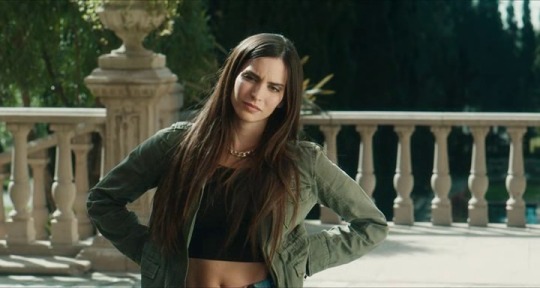
2023 Horror Challenge: [52/?]
↳“When in doubt..."
"Trust my brain, not my eyes." Delirium (2018) dir. Dennis Iliadis
Plot: A man recently released from a mental institute inherits a mansion after his wealthy parents die. After a series of disturbing events, he comes to believe it is haunted.
Starring: Topher Grace, Patricia Clarkson, Callan Mulvey, Genesis Rodriguez & Robin Thomas
Trying to get in some watches in today seeing as we've officially reached the week mark until Halloween and I only have so many off days in between that time (Halloween just so happens to be one of those days) so who knows how many more I'll manage to watch. I always have sooo many movies I wanna watch every year but when it comes to crunch time, I always forget major ones I meant to check out. Sometimes because I end up watching things I probably never fully intended to. Kinda like this one. lol I was vaguely curious about it because I do like Topher enough as an actor so I was interested in seeing him in a horror movie setting. I personally think he did a fine job. I cared enough about his character as he slowly questioned his sanity throughout the movie. There were plenty of other familiar faces in here as well, which is always nice. It did feel like they were mostly underused though imo, especially Patricia Clarkson, considering she's so great and her role felt pointless by the end. The story had some twists, which I appreciated, but they weren't necessarily groundbreaking so it's not like I was mindblown by them, but they were pretty good. And the action does get intense too. I will say there was a moment where we learn some backstory that felt a little lazy because it's just the main character talking about it in a way where I wished they had been able to intercut some flashback shots or something while he spoke cuz that was kinda awkward. First rule of writing: Show don't tell, people! But yeah, otherwise, they did what they could to make you wonder if certain things were real or just in Tom's head until it was pretty obvious it wasn't actually a ghost story. As far as a Blumhouse Production, I wouldn't say it was necessarily one of their better ones, but it was certainly watchable so there's that. I didn't hate it but yeah, could have used some tweakings. Overall, it was okay though I guess.
1 note
·
View note
Text
Johnny Depp 21 Jump Street
Johnny Depp is a versatile actor known for his incredible range and ability to bring complex characters to life on the big screen. One of his most memorable early roles was as Officer Tom Hanson in the hit television show "21 Jump Street". Here are some reasons why you should watch Johnny Depp in "21 Jump Street":
Depp's breakout performance: "21 Jump Street" marked Johnny Depp's first significant role in television, and he quickly became a breakout star. His performance as Officer Hanson was nuanced and layered, showcasing his natural talent for acting.
Complex character: Officer Hanson is a complex character with a troubled past. He profoundly empathizes with the troubled youths he encounters in his work and uses his experiences to connect with them. Depp's portrayal of Hanson brought depth to the character that resonated with audiences.
Iconic 80s style: "21 Jump Street" was set in the 80s, and the show's fashion has become iconic. From the hairstyles to the clothing, the show captures the essence of the decade. With his trademark leather jacket and calm demeanor, Depp's look as Officer Hanson became an instant classic.
Social commentary: "21 Jump Street" tackled critical social issues, such as drug use and gang violence, and Depp's portrayal of Officer Hanson added a layer of social commentary. Hanson's empathetic approach to policing and his desire to make a positive difference in the lives of young people highlighted the importance of community outreach and understanding in law enforcement.
Cultural significance: "21 Jump Street" is a cultural touchstone for a generation. It was one of the first shows to tackle issues facing young people in a realistic and relatable way. Depp's performance as Officer Hanson helped make the show a phenomenon and cemented his place in pop culture history.
In conclusion, Johnny Depp's performance as Officer Hanson in "21 Jump Street" is a must-see for any fan of his work. His nuanced portrayal of a complex character in a groundbreaking show significantly impacted popular culture and showcased his incredible acting talent. Take advantage of the chance to see Depp in one of his most iconic roles.
Johnny Depp 21 Jump Street T-Shirt
If you're a fan of Johnny Depp and his breakout role as Officer Tom Hanson in "21 Jump Street," you should consider buying a Johnny Depp 21 Jump Street t-shirt. Here are some reasons why:
Show your love for Johnny Depp: By wearing a Johnny Depp 21 Jump Street t-shirt, you can show your love and support for Johnny Depp and his work. It's a great way to let people know you're a fan and appreciate his performances.
Unique design: The Johnny Depp 21 Jump Street t-shirts often feature unique and eye-catching designs, making them stand out from other shirts. This can be a great way to show off your individuality and sense of style.
Nostalgia: "21 Jump Street" was a popular show in the 80s and early 90s, and the Johnny Depp 21 Jump Street t-shirts can bring back feelings of nostalgia and fond memories of the show. It's a great way to relive a piece of pop culture history.
Conversation starter: Wearing a Johnny Depp 21 Jump Street t-shirt can be significant. You might meet other show fans or people interested in Johnny Depp's work and want to know more about it.
Limited edition: The Johnny Depp 21 Jump Street t-shirts are likely restricted edition items, so they will only be available for a while. Buying one now ensures you will take advantage of the opportunity to own a piece of memorabilia from this iconic show.
Support small businesses: Small companies or independent artists sell many of the Johnny Depp 21 Jump Street t-shirts. By buying one, you're supporting a small business or artist and helping them continue to create unique and exciting designs.
In conclusion, buying a Johnny Depp 21 Jump Street t-shirt is a great way to show your love and support for Johnny Depp, display your individuality, relive a piece of pop culture history, start conversations, own a limited edition piece of memorabilia, and support small businesses or independent artists. Take advantage of the chance to add a unique item to your wardrobe.

0 notes
Text
SPIDERMAN: No Way Home
⚠️Spoilers⚠️
[TLDR at the end!]
A while ago I made a post about how I love when civilians or other people realize just how young their super hero is.
I ended up seeing a lot of that in the new Spiderman movie- specifically through the symbolism of LEGOs. Though, the people he saves realizing he's just a kid isn't new. When Tobey Maguire's Spiderman is revealed for the first time (Spiderman 2) on a train full of people he's just nearly died saving, the first words uttered are "He's just a kid".

Dr. strange constantly says that he keeps forgetting that Peter is a kid. On top of that, Peter is the youngest Spiderman (at least out of the 3), and the other Spidermen keep trying to save him from going through the same things that they went through which caused them to become bitter or hardened. (Andrew Garfield's Spiderman saves Tom Holland's MJ, since he couldn't save Gwen. Tobey keeps Tom from killing the Green Goblin out of revenge like Tobey did to Uncle Ben's killer.)
There's more that could be said, but let's get into the LEGO symbolism, shall we?
In the first Tom Holland Spiderman movie, his identity is revealed to his friend Ned because they were going to build a LEGO Death Star together, but Peter's Spiderman duties got in the way.
Not to mention it breaks- shattering like his chances at a normal childhood. He was forced to grow up too fast & take on all this responsibility.

This is a recurring theme in all Spiderman media, with Spiderman duties getting in the way of his life as Peter Parker. (This is especially prevalent in the Tobey Maguire Spiderman movies)
In No Way Home, Doc Oc asks peter if the LEGOs on the table are his, but he gets interrupted due to his Spiderman duties before he can answer, once again showing that Spiderman takes agency over his life.
At the very end of the film, once Peter has lost everyone he's held dear from his personal life, he goes out as Spiderman in a slightly new suit. However, before he goes out, he unpacks a single LEGO figurine from a box, and places it on his desk, before leaving it behind to be Spiderman.

It once again signifies that he's just a kid with too much responsibility who never got to really be a kid between saving the word and losing everyone he loves. He missed out on a lot of normal teen experiences like parties, homecoming, etc in order to fulfill his duty.
TLDR; The LEGOs in Tom Hollands Spiderman films are a reoccurring theme that represent his youth/childhood. The LEGOs are always shown before his attention is diverted due to Spiderman duties. He has to sacrifice his childhood in order to fulfill his responsibilities as Spiderman.
I doubt this is anything new or groundbreaking, but I've been thinking about it a lot since I saw the movie & I appreciated the symbolism. I have so many theories for how the next movie is gonna go, but I'm also still emotionally devastated from No Way Home 💀 Yall I was crying so much in the theater- it was so embarrassing 😳
Anyway, I'd love to hear what you think whether it's about the LEGO symbolism, theories or other details you noticed 👀
#spiderman no way home spoilers#no way home spoilers#spiderman#no way home#tom holland spider man no way home#tom holland#tom holland spiderman#tobey maguire#tobey maguire spiderman#andrew garfield#andrew garfield spider man no way home#andrew garfield spiderman#tobey maguire spiderman no way home#spiderman theory
43 notes
·
View notes